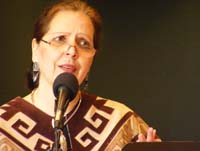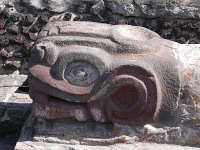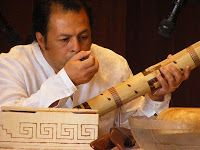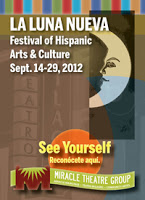La Luna Nueva — Miracle Theatre Group’s festival of Hispanic arts and culture from around the world in celebration of Hispanic Heritage Month — opens in just a couple of weeks, and we couldn’t be more excited about the diverse line-up (see the whole schedule in English; vea el horario completo en español). Our Marketing Assistant Stefanus Gunawan continues his look backstage visits with our guest artists, offering an inside look at their life, their passion, their art. Here, guest blogger Stefanus Gunawan chats with poetay y escritora, Cindy Williams Gutiérrez.
In her La Luna Nueva festival show, Cindy Williams Gutiérrez re-imagines a Mesoamerican literary event that took place circa 1490 in which Aztec poet-king Tecayehuatzin returns from the Land of the Fleshless to invite three female poets — one from pre-Conquest Mexico, another from colonial New Spain, and the third from contemporary Mexican Diaspora — to debate the purpose of poetry, or “Flower and Song”. Will the winner be able to alter the course of history? Audiences will find out at this evening of theatre, dance and music at 7 p.m., Friday Sept. 14.
Cindy, would you mind telling a bit of yourself?
 I’m originally from Brownsville, a Texas border town along the Río Grande. I’ve been writing poetry and plays since I was a child: the page was my confidante and the stage was a way to connect with people in a communal setting. As the oldest in the family, I pursued a “pragmatic” career and became a computer scientist and then a marketing executive in Silicon Valley. I left the “corporate” world just before my 39th birthday to start my own boutique marketing consulting firm and, mainly, to become a serious writer.
I’m originally from Brownsville, a Texas border town along the Río Grande. I’ve been writing poetry and plays since I was a child: the page was my confidante and the stage was a way to connect with people in a communal setting. As the oldest in the family, I pursued a “pragmatic” career and became a computer scientist and then a marketing executive in Silicon Valley. I left the “corporate” world just before my 39th birthday to start my own boutique marketing consulting firm and, mainly, to become a serious writer.
For my 50th birthday, I went back to graduate school to earn an MFA in Creative Writing with concentrations in Mesoamerican poetry and creative collaboration. I also studied playwriting as a second genre. Now I divide my time between providing strategic planning and marketing consulting for healthcare companies and nonprofits, and teaching poetry and playwriting to youth (through the Portland Art Museum, Right Brain Initiative, Wordstock, and Writers in the Schools) and to adults (out of my home in the hinterlands of Oregon City).
My first collection, the small claim of bones, is due out this fall from Bilingual Press/Editorial Bilingüe of Arizona State University. It is dedicated to my parents: for my father, admirer of Tenochtitlan, and my mother, keeper of the old ways of New Spain.
Artistically speaking, how does the intimate stage of Milagro Theatre bring out the most for your reading?
I love the intimacy of the Milagro Theatre. For me, it allows the audience to be easily transported to another world. This is essential for my play, A Dialogue of Flower & Song, since most of it is set “in a place where time flows in all directions.” There is a scrim separating the Land of the Fleshless from the contemporary world and the imagined, timeless world where most of the action takes place. I love that the Miracle’s intimate stage brings the audience close to the “veil of time,” that, as the actors stand behind the scrim, the audience will viscerally experience the opening words of the play:
“Here, in the Land of the Fleshless,
we are with you still—here,
just beyond the veil of time.”
Will there be live music? If so, what is the process of choosing the music which will be played during the performance?
From the moment of the play’s inception five years ago, the music was a collaborative effort. I wanted to be true to the song-like quality of 15th-century Nahau poetry which was chanted accompanied by music and dance. (The Nahuas were the seven Mesoamerican tribes in the central valley of Mexico who were conquered by the Spaniards.)
I met Gerardo Calderón (of Grupo Condor) through the Miracle. We met in a café where I asked him if he would be interested in collaborating with me on a verse play that takes place in pre-Conquest Mexico. He asked me one question: “Why?” I said I was fascinated by the beauty and mystery of Nahua poetry. He said: “Let’s do it.” Then I showed him some non-lexical cues that I had found in a book by Mesoamerican scholar Miguel León-Portilla, and I asked him how he “heard” these musical cues. He began drumming his fingers on the table. It was the same way that I heard them. This was the beginning of a long and meaningful artistic relationship.
By the summer, we had begun performing together a program called “The Poetry & Music of Ancient Mexico” which was later selected by Humanities Washington as part of the Inquiring Mind series. For the past five years, we have performed my Aztec-inspired poems accompanied by Gerardo’s pre-Hispanic music (on water drums, turtle shell, butterfly cocoon rattles, wind whistles, and rain stick) at colleges, museums, and libraries through the Northwest. We also performed in the Miracle’s Luna Nueva Festival for two years and at the largest national writing conference, Associated Writing Programs (AWP), in 2009. Gerardo was also invited to perform in a previous reading of my play by my alma mater, the University of Southern Maine Stonecoast MFA Program, which was recorded and available via podcast by Maine Humanities.
This year’s La Luna Nueva festival is made possible with the support of PGE Foundation, The Oregonian, Oregon Arts Commission, Regional Arts & Culture Council and Work for Art. Festival events occur September 14-29, 2012 at El Centro Milagro, 525 SE Stark Street, Portland, Oregon 97214; a complete schedule is available here. Admission varies; several events are FREE. Purchase tickets at 503-236-7253 or www.milagro.org (follow links for “La Luna Nueva” in right-hand sidebar).



